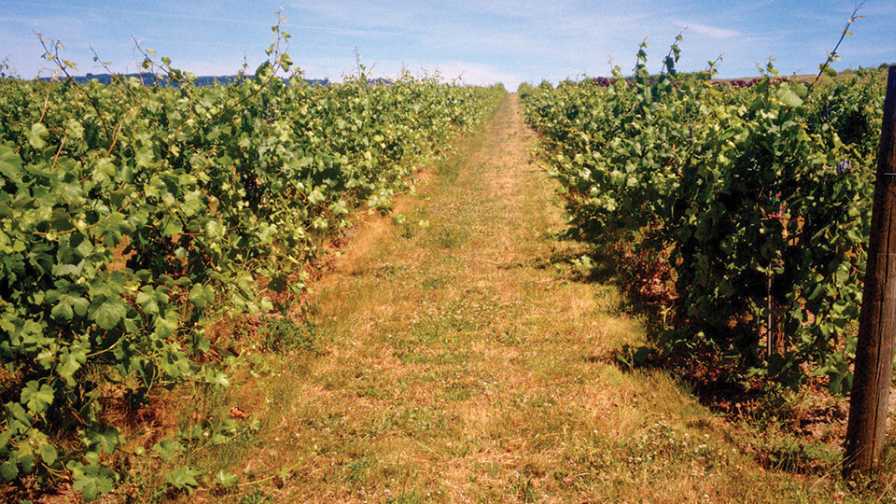What You Can Learn from French Wine Grape Production

Here’s a single wire vineyard trellising system in Oregon. Note the necessarily wide rows to accommodate the unpositioned shoots. However, the canopies are open, and sunlight can get into most parts of the vine, and all without any canopy manipulation.
Photo by Glen Creasy
When it comes to producing high-quality grapes, every country has its methods. To learn more about the happenings abroad, we reached out to Glen Creasy, co-author of “Grapes: Crop Production Science in Horticulture.” Creasy, who co-authored the book with his father, Leroy, a viticulturist in France. He’s also worked in the U.S. and New Zealand and was able to give insights about the growing processes in these places. Here’s what he had to say:
Q: How does grape production vary in France, New Zealand, and the U.S.?
A: In comparing different grape-growing countries and regions, you will always have differences in soil, climates, and varieties planted. Generalizing across countries is problematic, as some countries have significant variation within them. Compare New York with California, for example, and you have huge differences in the practical aspects of which grapes are grown, how, and for what purpose. France has a similar range in climates and soils, but if you look at a small country like New Zealand, it’s much more limited, climate-wise in particular (it has quite a range of soil types). This situation necessarily limits the kinds of grapes that are grown and what they’re used for.
There are some definite differences among countries, however. After having worked exclusively in New World wine countries, my firsthand experience with grape production in France was an eye opener! I was aware there are regulations around production, but the degree to which the management and setup of the vineyards is prescribed was a bit of a surprise.
Q: What can U.S. growers learn from the grape growers in other countries?
A: It’s easy to convince yourself that because grape growers in other countries don’t have the same conditions/varieties/markets, etc. there isn’t much to learn from them. If you do want to see how they do things on the other side of the international fence, you can read about how grapes are produced in other areas, which is helpful. But in my experience, it’s not quite the same as visiting a place and speaking with growers.
A popular saying in my household is “travel is best thought of as an investment, not a cost.” When it comes to viticulture, this is still a good rule of thumb. So much of viticultural management comes down to the details. In reading about growing grapes, you get a good outline. Pictures add depth. Watch a video and you start to get an idea of how things are actually done. But to get the full experience, there is no substitute for immersing yourself in the vines and discussing how they’re grown and the challenges that the manager faces.
Q: What are the biggest challenges for grape growers?
A: I feel the two biggest challenges (and these are not limited to the U.S.) going into the future are climate change and decreased availability of pesticides.
Climate change is occurring at a relatively rapid rate (especially given the long life of a vineyard) and will mean we need to change the way we’re doing things, as well as increase the risk of farming. In terms of managing vines through these changes, it’s often the extremes that will bring our biggest challenges. For grapes, many of these weather events can result in a significant, if not complete, loss of crop.
The other major challenge has to do with chemical use in agriculture. There are two main reasons for this: 1) development of resistance in target organisms, and 2) increased legislative restrictions on their use. In many cases, resistance development has been hastened by poor strategic use of single-site-of-action synthetics. But even with appropriate use, it is likely the pest will mutate to become tolerant. Multi-site-of-action pesticides are more difficult to develop, and we are looking at the potential for pesticides becoming ineffective more quickly than new ones coming onto the market.

Pictured is a high wire Sylvoz training system in New Zealand. In this case, there is a single wire for the cordon which is near the top of the canopy. Canes are tied down to a lower wire to achieve a high number of nodes per meter of row. There is also a mid-wire Sylvoz, which could be adapted from a VSP system by running a new wire to tie canes to below the fruiting wire; the top of the system would remain the same.
Photo by Glen Creasy
Q: What kinds of training and trellising systems are used in New Zealand and France? How do they compare to those used in the U.S.?
A: In New Zealand, a cool climate growing area focused pretty much exclusively on wine production, most of the industry is based on vertical shoot positioning (VSP). However, there are significant portions of Sylvoz to boost yields. Training can be anywhere from one to four canes per vine, with up to two fruiting wires. Spur pruning is used more as you move north in the country, where the weather is warmer. Row spacings were typically 2.8 to 3 meters (9 to 10 feet) in the past, but more recently they’ve been coming down to 2.4 (7.9 feet) meters or even less.
Vine management tends to be intense, with shoot positioning followed by mechanical leaf removal and top and side hedging (rows are generally kept very tidy looking). Harvesting is almost all by machine, a method that actually helps develop the typical Marlborough style of ‘Sauvignon Blanc’ (through partial maceration of the fruit and additional time on skins).
France, like the U.S., is a big place with lots of different types of grapes grown, therefore, different trellising systems. There are meticulously tended VSP systems all the way through to hairy looking bush vines, depending on how old the vineyard is and what it’s for.
Q: What are the biggest differences in varieties in each of the three countries?
A: For a general sense, you can’t go past data from the International Organization of Vine and Wine. In 2016 they reported these as the top three varieties in France, the U.S., and New Zealand:
- France: ‘Merlot’ (13.9%), ‘Ugni Blanc’ (10.2%), ‘Grenache’ (10.0%)
- U.S.: ‘Thompson Seedless’ (13.5%), ‘Chardonnay’ (9.7%), ‘Cabernet Sauvignon’ (9.3%)
- New Zealand: ‘Sauvignon Blanc’ (60.2%), ‘Pinot Noir’ (15.1%), ‘Chardonnay’ (8.4%)
However, as mentioned earlier, the varietal mix depends on the region you’re talking about. For example, in New Zealand, as you might guess, ‘Sauvignon Blanc’ is king (making for a very top-heavy industry!), but go north to Gisborne, and ‘Chardonnay’ is the most planted grape. Hawkes Bay has a sizable chunk of ‘Merlot.’ Canterbury is noted for its focus on ‘Riesling,’ and in the south; Central Otago is dominated by ‘Pinot Noir.’
France has a similar region-determines-variety feature, but what worked in terms of climate and wine style has been enshrined into legislative rules. This is, I think, ultimately limiting the industry. Fortunately, it is becoming more common to see grapes grown outside of the regulations. This means they cannot be sold as Appellation d’Origine Protégée wines. But it does mean you are free to experiment and see what works best wherever you may be.










